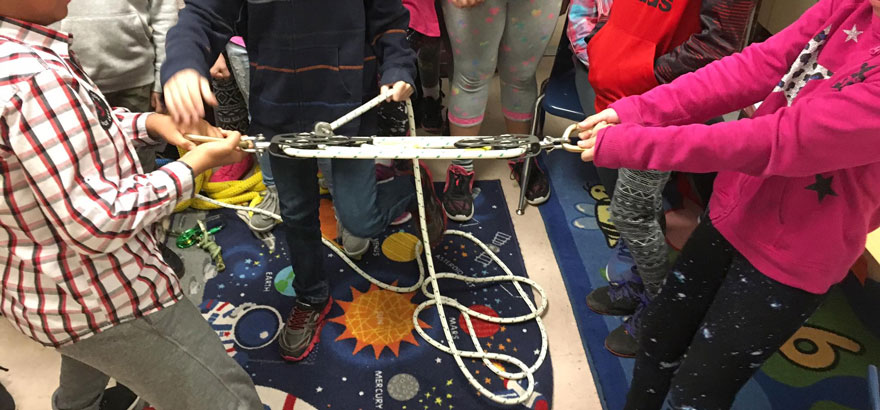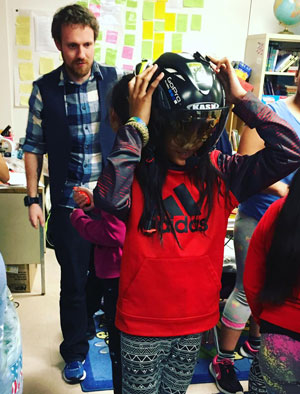
Did you ever think about the amount of physics, math and biology knowledge needed to be an arborist?
Most people don’t. And if you tell kids what they’ll need to know, many would never choose to become an arborist!
But if you show them how it all works, and make it fun at the same time, then you might just convince a few kids to study arboriculture. Plus, you can help teach them some basic principles of science.
Each year I participate in the Kiwanis Bringing Up Grades (BUG) Program, where I go into 5th grade classrooms to share my experiences as an arborist, help the kids understand more about trees and how they relate to their everyday world, and yes, have a little fun!
The Bring Up Grades or “BUG” program is sponsored by the Kiwanis Club Foundation of Greater Danbury. To participate, students select a subject in which to bring up their grade from the previous marking period grade. The students must continue to maintain their other grades.

Trying out the helmet – always a hot ticket item!
During the classroom visit, I relate physics, math and biology to the kids and talk about how I get paid to climb trees and run big equipment (that usually gets their attention!).
I like to throw out a few vocabulary words and always use “dendrochronology” (a real tongue twister!) which is the scientific study of tree rings and determining dates of events during the years of the tree’s growth. To bring it to life, I put up a picture of giant redwood log with a guy standing next to it. The rings on the tree show its timeline from 550 to 1891 and we can talk about all the major events this tree saw.
I also talk about safety, and especially about power lines that come down in storms and what to watch for to avoid electrocution. We go into step voltage and how it can travel through the ground – that gives us a good excuse to practice the Michael Jackson moonwalk to get away from the wires without lifting our feet!
To really bring the message home, I show them a big chunk of glass that came from the side of the road where 14,400 volt wires came down and heated the sand to 3200 degrees and melted it to glass. Wow.
Then we talk about how a tree produces sap, how it moves around the tree and how maple syrup is made. That leads into a discussion of how arborists give trees injections to help them survive and to control diseases and infestations (just like a doctor does).
Lastly, we get into physics with a discussion of how to gain a mechanical advantage using pulleys and ropes. This is where I break out the “bling bag” full of gear. We talk about how with a fiddle block we can gain a 4:1 advantage. Then I have the two biggest kids grab each end like tug-of-war and the smallest kid in the class pulls the draw rope – the end result is that the smaller kid can effortlessly pull the big kids together. Of course they all want to try that!
We end with show and tell, showing off gear and helmets with bluetooth radios and harnesses, etc. They ask lots of gear questions, wanting to know what each item is and what it does. Kids also want to know how high an arborist can climb in a tree, how much money we make, what we do when it’s snowing or raining outside, and a ton of other questions. Many of them tell me stories of when they saw someone doing tree work by their house.
And then there are the few who after it’s all over say to me “I know what I want to be when I grow up – an arborist.” That always makes my day!



